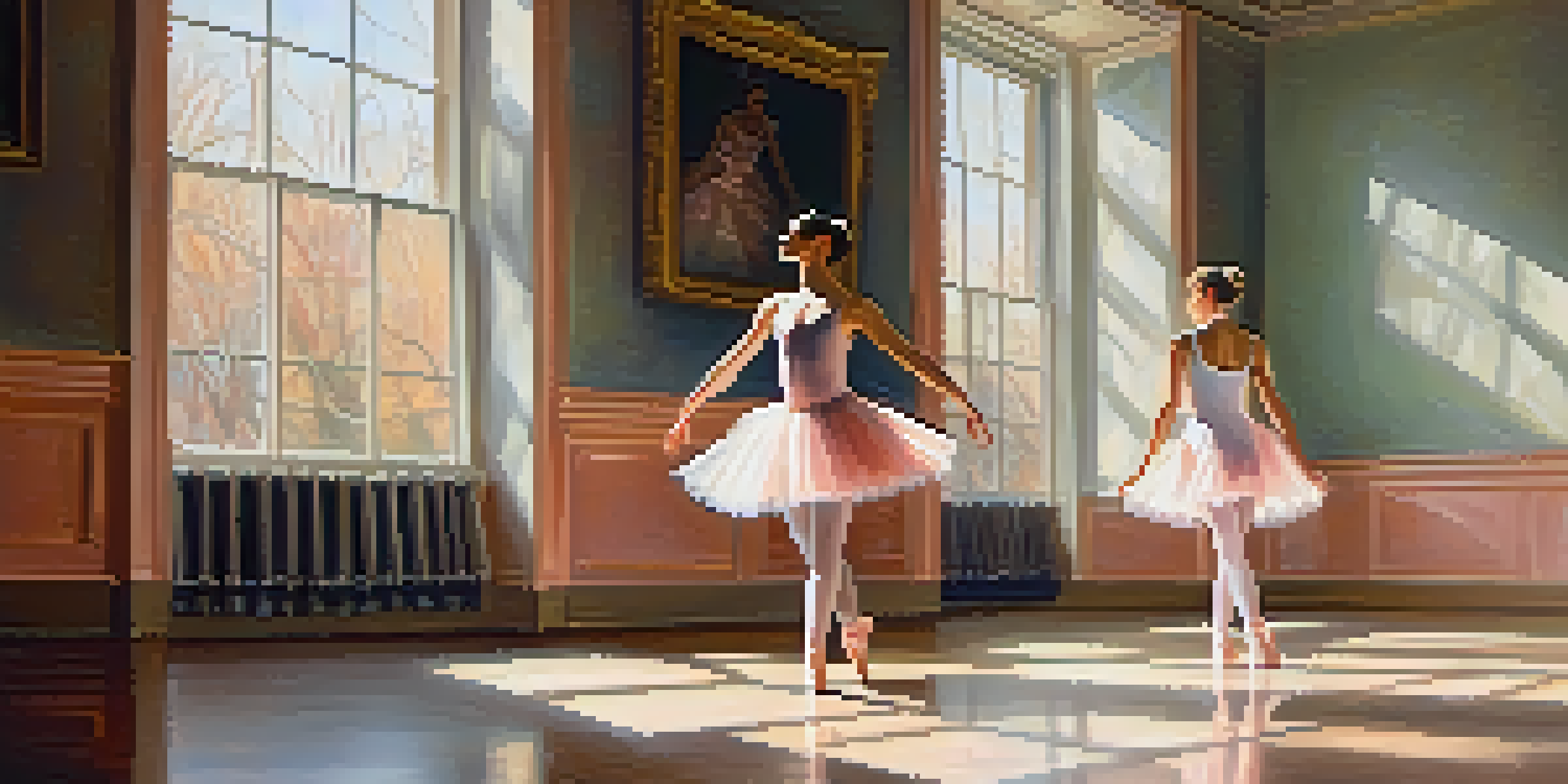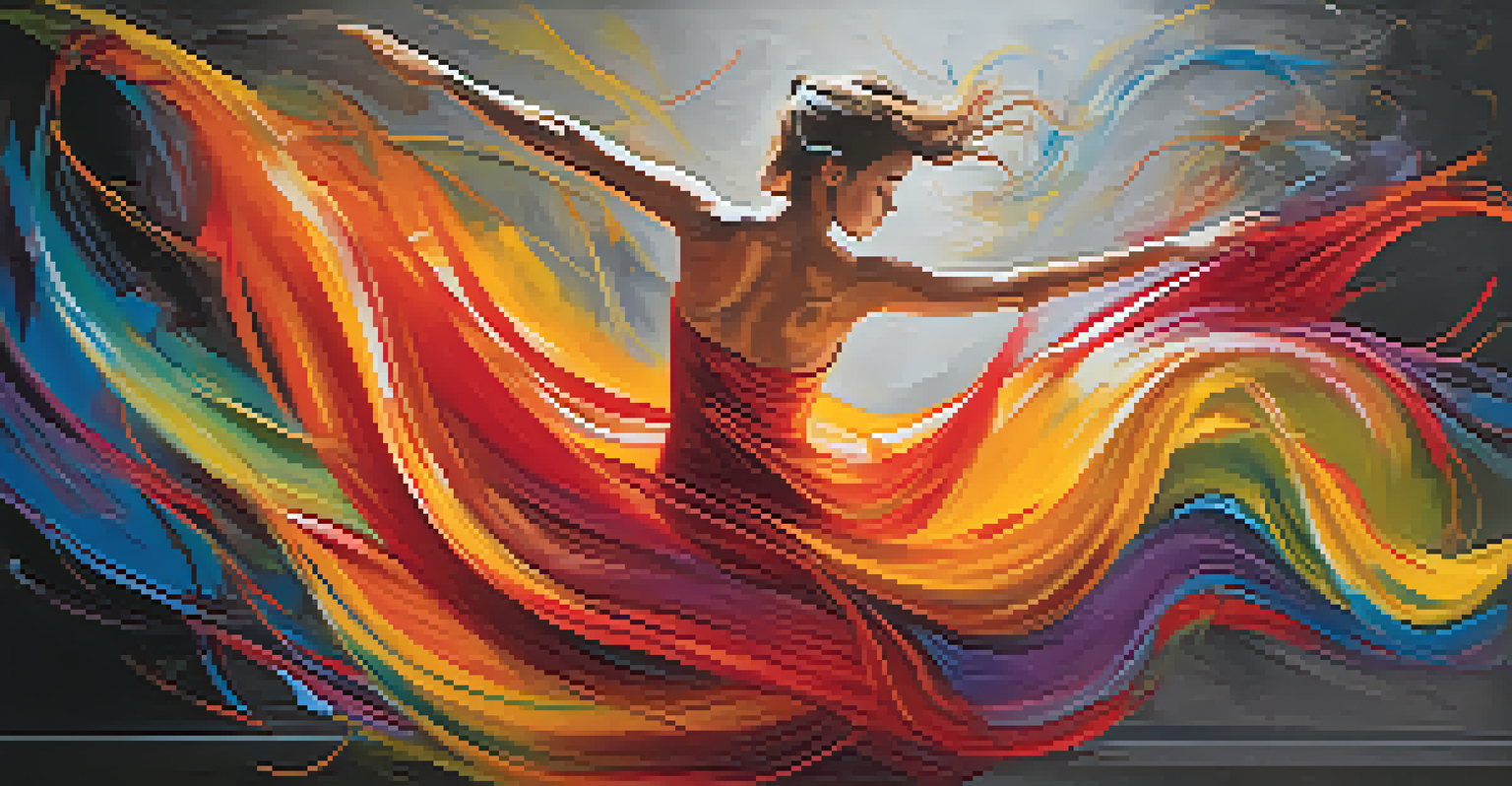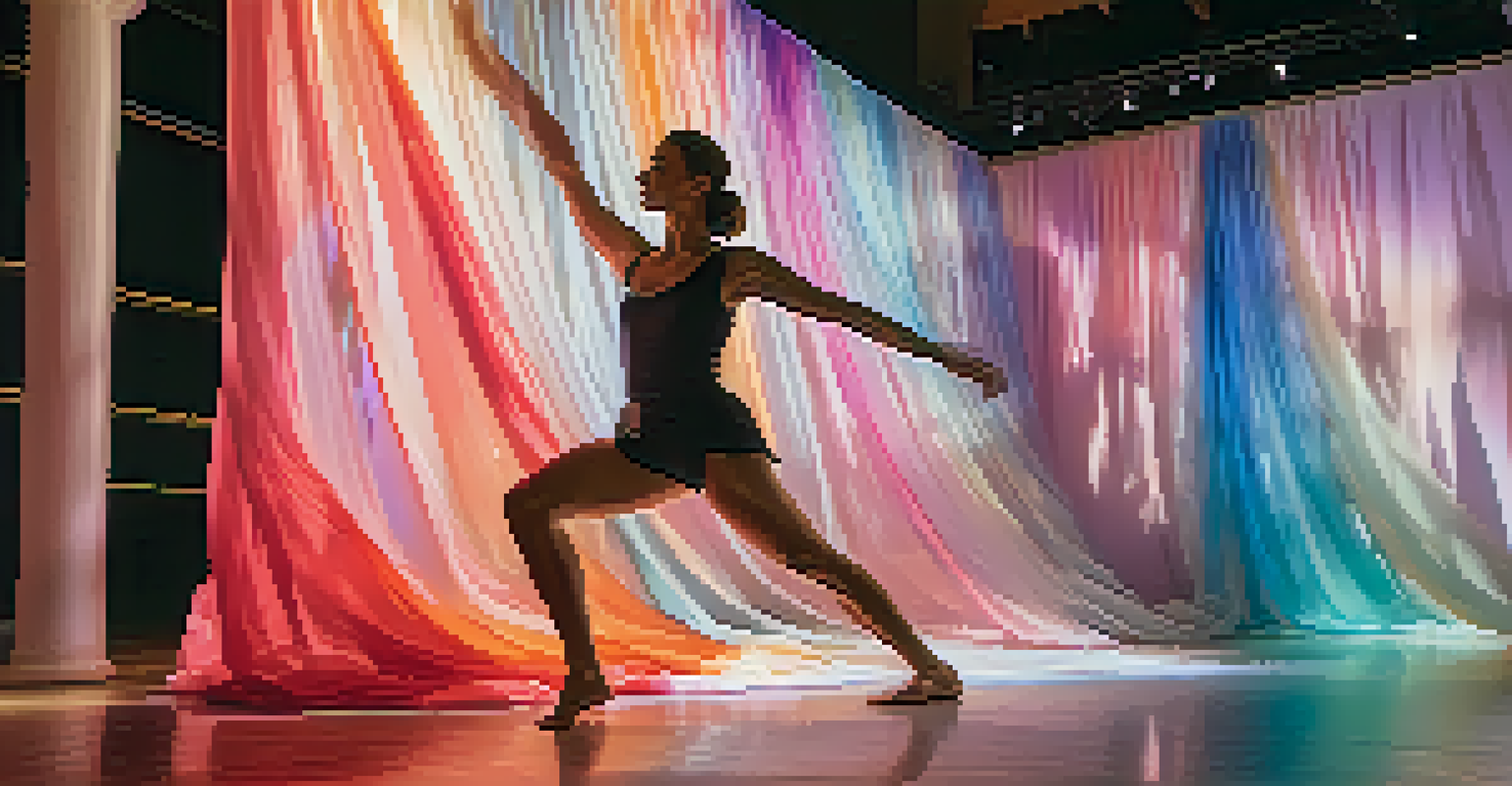Exploring Dance's Impact on Contemporary Visual Art Forms

The Dance-Art Connection: A Historical Overview
Dance and visual art have long shared a rich historical dialogue. From ancient rituals to modern performances, movement has been a source of inspiration for countless artists. For instance, the fluidity of ballet often mirrors the grace found in classical sculptures, demonstrating how these forms can influence each other.
Dance is the hidden language of the soul.
Throughout history, movements like the Dada and Surrealism embraced dance as a form of expression, emphasizing spontaneity and emotion. This cross-pollination has allowed artists to explore themes of movement, rhythm, and space in their work. As artists and dancers interact, they create a dynamic environment where ideas can flourish and evolve.
In contemporary settings, this relationship continues to grow, with collaborations becoming increasingly common. Artists are drawing from dance to enhance their work, while choreographers are inspired by visual art to inform their movements. This ongoing exchange enriches both fields, leading to innovative expressions that captivate audiences.
Movement as a Medium: Dance in Visual Art
The concept of movement itself has been transformed into a visual art medium, with many artists capturing the essence of dance in their work. For example, the kinetic sculptures of artists like Alexander Calder embody the idea of movement, inviting viewers to engage with the art actively. These pieces often evoke the fluidity and grace of dance, allowing onlookers to experience a sense of rhythm through their interaction.

Moreover, artists like Martha Graham have incorporated dance principles into visual art, creating pieces that convey emotion and narrative through movement. This approach allows viewers to connect with the artwork on a deeper level, as they can see and feel the energy that dance embodies. The emphasis on movement not only enhances the visual appeal but also tells a story that resonates with the audience.
Dance and Art: A Rich History
Dance and visual art have historically influenced each other, leading to innovative expressions that captivate audiences.
This interplay between dance and visual art encourages a fresh perspective on both forms. As artists continue to explore the theme of motion, they invite viewers to consider the beauty of movement and its role in shaping our experiences. This artistic dialogue ultimately enriches the cultural landscape, prompting us to appreciate the nuances of both dance and visual art.
Choreography in Art: Creating Visual Narratives
Choreography extends beyond the stage and into the realm of visual art, where artists often choreograph their compositions to create dynamic narratives. Artists like Julie Mehretu use layers and gestures to construct complex visual stories, much like a choreographer designs a dance piece. This synthesis of movement and visual storytelling captivates audiences, inviting them to explore the layers of meaning in each artwork.
Art is the most beautiful of all lies.
Additionally, the concept of choreography can be applied to the arrangement of elements within a piece of visual art. By considering the flow and interaction between shapes and colors, artists create a sense of motion that draws the viewer's eye. This deliberate structuring mirrors the precision of dance, emphasizing the importance of rhythm and timing in both disciplines.
Ultimately, this creative merging allows artists to express emotions and concepts in ways that resonate with viewers. As audiences engage with these visual narratives, they are reminded of the inherent beauty found in both dance and visual art. This collaboration fosters a greater appreciation for the artistry involved in each medium, highlighting the power of movement as a form of expression.
Dance as Inspiration: Artists Reflect Movement in Their Work
Many contemporary artists draw inspiration from dance to inform their artistic practices. For instance, the works of artists like Ann Hamilton often reflect the fluidity and rhythm of movement, creating an immersive experience for viewers. These pieces serve as a testament to how dance can spark creativity, leading to innovative approaches in visual art.
By observing dancers and their movements, artists can capture the essence of motion in their work, translating it into visual forms. This process can be seen in the abstract paintings of artists like Jackson Pollock, whose energetic brushstrokes evoke a sense of dance and rhythm. Such pieces encourage viewers to engage with the artwork on a visceral level, as they can almost feel the energy of movement radiating from the canvas.
Movement Transforms Visual Art
Many contemporary artists draw inspiration from dance, incorporating its principles to create immersive and emotionally resonant artworks.
This artistic synergy not only enhances the visual experience but also fosters a deeper understanding of both disciplines. As artists continue to explore the influence of dance, they create opportunities for audiences to appreciate the beauty of movement in new and exciting ways. This ongoing dialogue between dance and visual art ultimately enriches the cultural tapestry we experience.
The Role of Performance Art: Merging Dance and Visual Aesthetics
Performance art serves as a powerful platform that merges dance with visual aesthetics, blurring the lines between these two art forms. Artists like Marina Abramović have used movement and physicality to create immersive experiences that challenge viewers' perceptions and emotions. This fusion allows for a unique exploration of human connection, vulnerability, and expression.
Through performance art, the body becomes a canvas, and movement becomes a means of storytelling. Audiences are invited to witness the transformation of space and time, as artists choreograph their actions to evoke a range of emotions. This live interaction heightens the experience, making it more personal and immediate for viewers.
As the boundaries between visual art and dance continue to dissolve, the impact of performance art grows. It allows for innovative explorations of identity, culture, and societal issues, encouraging audiences to engage with the art on multiple levels. This collaborative spirit not only enriches the art world but also fosters a sense of community among artists and viewers alike.
Digital Dance: Technology's Influence on Visual Art
In today's digital era, technology has significantly influenced the relationship between dance and visual art. Artists are increasingly using digital tools to capture and manipulate movement, creating immersive experiences that transcend traditional boundaries. For example, video installations often showcase recorded dance performances, allowing viewers to engage with the art in innovative ways.
Moreover, advancements in virtual reality (VR) and augmented reality (AR) have opened new avenues for artistic expression. Artists can now create interactive environments that allow audiences to experience dance in a completely new context. This fusion of technology and movement not only enhances the visual experience but also invites viewers to participate in the artwork actively.
Collaboration Enhances Artistic Expression
The partnership between visual artists and dancers fosters a multi-sensory experience, resulting in unique projects that highlight the strengths of both disciplines.
As technology continues to evolve, so too will the relationship between dance and visual art. This ongoing exploration encourages artists to push the limits of creativity, leading to groundbreaking works that challenge our understanding of both disciplines. The digital realm offers endless possibilities for collaboration, ensuring that the dialogue between dance and visual art remains vibrant and relevant.
Collaborative Projects: Artists and Dancers Unite
Collaboration between visual artists and dancers has become increasingly prevalent, resulting in powerful and innovative projects that highlight the strengths of both disciplines. These partnerships allow for the creation of unique works that blend movement and visual aesthetics, offering audiences a multi-sensory experience. For example, the collaboration between choreographer Crystal Pite and visual artist Jonathon Young produces stunning performances that seamlessly combine dance and visual storytelling.
By working together, artists and dancers can explore themes and concepts that resonate deeply with audiences. This collaborative approach fosters a sense of community as creators share their ideas and expertise, resulting in projects that are greater than the sum of their parts. As they navigate the creative process together, they push each other to think outside the box and challenge traditional boundaries.

Ultimately, these collaborative projects not only enrich the art world but also inspire future generations of artists. They highlight the importance of interdisciplinary dialogue, encouraging a deeper appreciation for the interconnectedness of various art forms. As we witness the ongoing evolution of these collaborations, we can anticipate even more exciting works that celebrate the beauty of both dance and visual art.